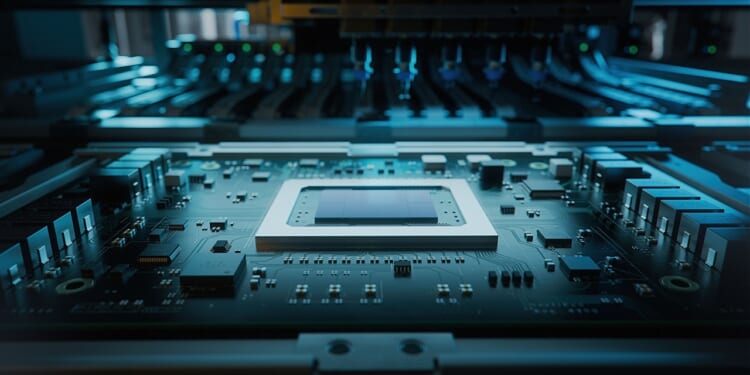America’s economic growth today is dependent on the success of the artificial intelligence sector—which might be crippled if China were to cut off chip imports to the United States.
A recent House Oversight Committee hearing entitled “Shaping Tomorrow: The Future of Artificial Intelligence,” might have been glossed over by an easily distracted press, but it’s worth understanding what some of the country’s leading technologists are thinking about the race for artificial intelligence (AI). More importantly, as the committee determined, “Beijing’s determination to dominate the [AI] field, and China’s increasingly threatening posture toward Taiwan,” make this issue a geopolitical concern as much as a matter of technological development and economics.
US Economic Growth Is Dependent on AI Growth
A few points for context.
America’s economy is a bit of a mess. On the one hand, unemployment levels are relatively low—around 4.3 percent—and while inflation is ticking up, it is still very near the Federal Reserve’s preferred target of 2 percent (it is currently hovering around 2.7 percent). At the same time, however, job creation has ground to a halt. This is both unexpected and worrying.
Nevertheless, a week ago, the S&P 500 reached a new high, its 27th of the year, and is up 13.5 percent in 2025, according to a recent report from Axios. Many have argued that the excessive gains of the stock market, despite the otherwise turgid US economy, has to do with the way in which the AI wing of the tech sector is generating investment and interest in this new, purportedly revolutionary product.
For the gains to continue, though, the US must ensure no disruption to the underlying infrastructure of the AI tech sector boom occurs. Furthermore, the US government must prioritize enhancing and expanding the infrastructure that supports the high-demand development needs for AI.
Essentially, the economy needs:
The Geopolitics of Artificial Intelligence
The basis of this economic whirlwind is computer chips of the kind that the American chip giant NVIDIA sells. The problem is that for many decades, the United States, the country that invented computer chips, has shuttered its domestic chip production and offshored it in places, like Taiwan, South Korea, and Japan.
While that may have been efficient and a sound policy in the wake of the Cold War, when the Americans ruled the world as the unipolar power, those days are over. With AI and the tech sector becoming the bedrock of the US economy, leaving chip production overseas—particularly in countries so near to China—is a grave strategic vulnerability.
This is especially so considering that Taiwan, the country in Asia that is most directly threatened by the Chinese military buildup, is the world’s leading manufacturer of these high-end chips. Today, despite a yearslong effort that cut across both the otherwise diametrically opposed presidencies of Donald Trump and Joe Biden, Taiwan still produces more than 90 percent of the world’s advanced computer chips. Without these high-end chips, there is no AI revolution, and US economic gains—such that they are—can evaporate overnight.
Currently, China is threatening Taiwan with either a blockade and/or an invasion. If that occurs, the world will lose access to Taiwan’s high-end chip production for at least several months, which will collapse America’s economy.
Can America Legislate Its Way to Success in the AI Race?
During the committee hearing, leaders called for a more comprehensive CHIPS and Science Act. Building off the $52 billion CHIPS Act of the Biden administration, which attempted to reshore at least some of the world’s high-end computer chip manufacturing here in the United States, Congress wants a new round of legislation that would go beyond what the CHIPS and Science Act of 2022 did.
But the CHIPS Act has not been the resounding success story that its proponents have claimed.
For example, the initial plan called for $150 billion to be committed to reshoring high-end chip production in the USA. But partisan rancor disrupted that plan. Republicans in Congress at the time demanded that no global warming or Diversity, Equity, and Inclusion (DEI) initiatives be included as part of the bill. The Democrats refused, and the $150 billion was halved to $52 billion.
Then there was the difficulty in rolling out the program itself. The Biden administration was not fixated on the immediate problem—getting high-end chip production built in the United States as quickly as possible. There was also the slow funding rollout which caused frustration among some of the tech companies involved.
In fact, most tech leaders have stated that the funding from the government was hardly sufficient to produce such herculean results, like reorienting 90 percent of the world’s high-end chip manufacturing from Taiwan to the United States.
Manufacturing incentives were the most well-funded of the group, while the research and development (R&D) that were a key component of the CHIPS Act have gotten the short shrift. What’s more, the DEI and childcare provisions of the CHIPS Act have complicated what should have been a lightning-fast effort to restore semiconductor production to the United States in some capacity before the Chinese military was able to seriously threaten Taiwan with attack.
Lastly, there has been a seemingly endless cascade of workforce shortages in relation to the CHIPS Act—which is astounding, considering how many STEM degree graduates in the United States are desperately looking for work.
There is obviously a mismatch in expectations of income and benefits with what the tech firms involved are willing to provide. Part of reshoring, though, is forcing these companies to provide livable wages and benefits to their employees. That is why so many have demanded reforms to the H-1B Visa program, which critics contend suppresses the wages of American workers.
Any CHIPS 2.0 legislation must address the shortcomings of the original legislation and pour far greater sums of money than what was dedicated before. In fact, if possible, the US government should directly provide payment to companies that hire American STEM graduates to work in their US-based fabrication facilities that must be built now.
Why Congress Hasn’t Acted on AI Policy
Samuel Hammond, the chief economist at the Foundation for American Innovation, urged lawmakers to not only embrace a new CHIPS Act, but to pass the GAIN Act. That proposed law would further complicate Beijing’s ability to keep up with the Americans in the global AI race by forcing chipmakers to prioritize selling their high-end products first to American firms before even contemplating selling them to Chinese companies. Sadly, there is not unanimous consent on the need for the GAIN Act—particularly within the Republican Party, which controls both houses of Congress today.
Indeed, Speaker of the House Mike Johnson had the GAIN Act language dropped from the recent House budget bill at the request of the White House—which is in hoc to the so-called “Broligarchs,” most of whom only supported Trump’s reelection bid last year because he promised to support their AI ambitions, whereas Biden and Democratic nominee Kamala Harris would not.
The Senate, however, is contemplating reinserting language from the GAIN Act into their version of the proposed budget bill. But given that the president and his own party are not on the same page when it comes to the GAIN Act, the only way that the law might be passed is through buy-in from Democrats in Congress, who would naturally want to tweak it for their own purposes. The ultimate endgame remains unclear.
The reason that Trump had his allies in Congressional leadership pull the GAIN Act language from the funding bill was not just because of his alliance with the “Broligarchs.” More seriously, it was because China now dominates the world’s rare earth mineral market. Without these essential elements, no advanced technology can be made at affordable levels or in mass quantities. In the ongoing trade war between China and the United States, Beijing has repeatedly used this dominance as leverage to get the Trump administration to back down repeatedly from their more hawkish stances on China.
As America Dithers, China Holds All the Cards on AI
Thus far, this play has worked for Beijing’s negotiators like a charm. This is one of the reasons that Trump ultimately allowed for NVIDIA to begin selling some of their higher-end chips to Chinese firms involved in AI development. It was an olive branch to Xi Jinping’s government—and part of a larger movement toward stabilizing the broken trade relationship with China.
American firms today lead the world in high-end AI development. Because of that, despite the economic struggles of the last five years, the US economy has continued to do well, at least from a Gross Domestic Product (GDP) perspective.
But should the US fail to move at least some of the chip production out of a potential combat zone, and should China successfully attack, blockade, or conquer Taiwan, a global depression will ensue. These are the stakes in the AI war. And few seem to comprehend this in Washington.
About the Author: Brandon J. Weichert
Brandon J. Weichert is a senior national security editor at The National Interest. Recently, Weichert became the host of The National Security Hour on America Outloud News and iHeartRadio, where he discusses national security policy every Wednesday at 8pm Eastern. He is also a contributor at Popular Mechanics and has consulted regularly with various government institutions and private organizations on geopolitical issues. Weichert’s writings have appeared in multiple publications, including The Washington Times, National Review, The American Spectator, MSN, The Asia Times, and others. His books include Winning Space: How America Remains a Superpower, Biohacked: China’s Race to Control Life, and The Shadow War: Iran’s Quest for Supremacy. His newest book, A Disaster of Our Own Making: How the West Lost Ukraine is available for purchase wherever books are sold. He can be followed via Twitter @WeTheBrandon.
Image: Shutterstock / IM Imagery.
















